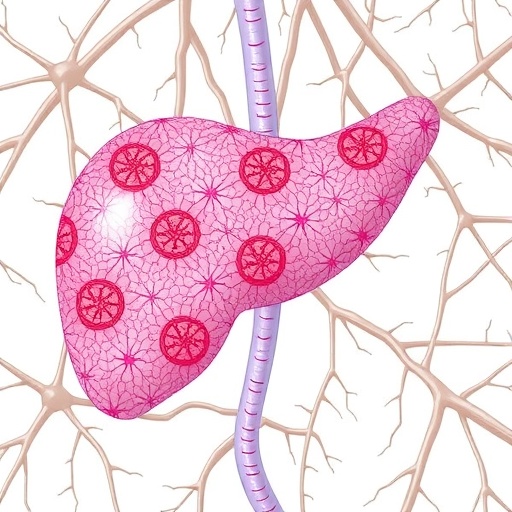In a groundbreaking study set to reshape our understanding of human physiology, researchers have delved deep into the complex arena of neuroanatomy, specifically examining the intricate innervation patterns of the human liver and pancreas. The work, spearheaded by a team led by Lee et al., promises to illuminate the mysterious roles these organs play in interaction with the nervous system. By resolving three-dimensional (3D) neurohistological challenges, this research is expected to unlock advanced insights into the neuroanatomical connections that are paramount to both organ function and overall human health.
The significance of liver and pancreas innervation cannot be overstated. Traditionally, these organs have been viewed through the lens of their metabolic and digestive functions. However, recent studies indicate that neural connections to these organs may play a role far beyond what was previously understood. The implications of the neuroanatomical relationships explored in this study could provide new perspectives on various diseases, including diabetes, liver cirrhosis, and other metabolic disorders.
One of the primary aims of the research was to utilize advanced imaging techniques that allow for the visualization of neural structures in 3D. In the past, histological studies have often relied on outdated two-dimensional imaging, which can lead to misconceptions about the three-dimensional arrangement of nerve fibers and their connections to target tissues. This research employed cutting-edge technology to obtain high-resolution images that showcase the astonishing complexity of the innervation of the liver and pancreas.
The team’s methodology involved a combination of neuroanatomical tracing, serial sectioning, and state-of-the-art imaging platforms capable of 3D reconstruction. By integrating these techniques, the researchers were able to map out the intricate nerve pathways that supply the liver and pancreas. The findings are not only crucial for understanding how these organs communicate with the nervous system but also provide potential pathways for therapeutic interventions that target these connections.
Another fascinating aspect of this study is its revelation of differences in innervation between healthy tissues and those affected by disease. For instance, the research highlighted altered nerve distribution patterns in cases of pancreatic disease. This suggests that changes in the nervous system’s architecture around these vital organs could contribute to the pathophysiology of chronic diseases. It raises the question of whether therapeutic strategies that target the nervous system could help mitigate such diseases.
The paper also discusses the implications of innervation on the function of the liver and pancreas. Specific neural signals may influence processes like insulin secretion, bile production, and metabolic regulation, which are crucial for maintaining homeostasis in the body. Understanding these connections may pave the way for novel treatments aimed at enhancing or restoring normal function in patients suffering from endocrine or metabolic disorders.
While the study has identified many critical nerve pathways, questions remain about the mechanisms through which these pathways exert their effects on organ function. Future research will likely focus on elucidating how specific neurotransmitters and signaling pathways operate within these structures. This may involve the application of pharmacological agents that can selectively activate or inhibit certain neural pathways to determine their physiological roles.
Moreover, the findings of this research extend beyond human health. The insights gained from mapping the innervation of the liver and pancreas could have implications for veterinary medicine, particularly in domestic animals that share similar physiological characteristics. The comparative approach to understanding organ innervation may enhance treatment protocols for various species, including pets and livestock.
As we embark on this new frontier of research, the integration of neuroscience with traditional biomedical sciences could lead to groundbreaking therapies that address previously intractable medical conditions. The complexity inherent in the nervous system’s interplay with organ function necessitates a multidisciplinary approach, fostering collaboration among neurobiologists, endocrinologists, and histologists.
The authors propose that future studies should focus on longitudinal analyses to observe changes in innervation over time in both healthy individuals and those with specific pathologies. Such studies will be essential in determining the plasticity of nerve connections and their long-term impacts on organ function. The potential for developing neural-based therapies is immense and calls for an urgency in advancing our understanding of these anatomical features.
The research team also emphasizes the importance of educating the next generation of scientists and clinicians about the complexity of organ innervation. As our knowledge expands, so too must our approaches to studying diseases that affect the liver and pancreas. Training in advanced imaging techniques will be instrumental in equipping the upcoming professionals with the necessary tools to unravel the complexities of human anatomy and physiology.
In summary, the revelations brought forth by Lee et al. research team mark a transformative step in our understanding of the neurology associated with the liver and pancreas. The findings advocate for a reconceptualization of these organs’ functions, emphasizing the role of innervation in their regulation and health. As research continues in this exciting area, the potential for novel interventions that target the nervous system will likely expand, offering hope to those affected by various metabolic and endocrine disorders.
The study teaches us that the body is not merely a collection of organs performing isolated functions but a highly integrated system where neural interactions play a foundational role in health and disease. As we advance into an era that prioritizes understanding the body as a network of systems, the insights provided by this research will remain critical in guiding future innovations in medicine and biology.
Subject of Research: Human liver and pancreas innervation.
Article Title: Human liver and pancreas innervation: resolving 3D neurohistological challenges and advancing insights.
Article References:
Lee, CY., Hsiao, FT., Chen, CC. et al. Human liver and pancreas innervation: resolving 3D neurohistological challenges and advancing insights.
J Biomed Sci 32, 97 (2025). https://doi.org/10.1186/s12929-025-01194-y
Image Credits: AI Generated
DOI: https://doi.org/10.1186/s12929-025-01194-y
Keywords: Neuroanatomy, liver innervation, pancreas innervation, 3D imaging, metabolic disorders, neurohistology, organ function, nervous system interaction, chronic disease.




